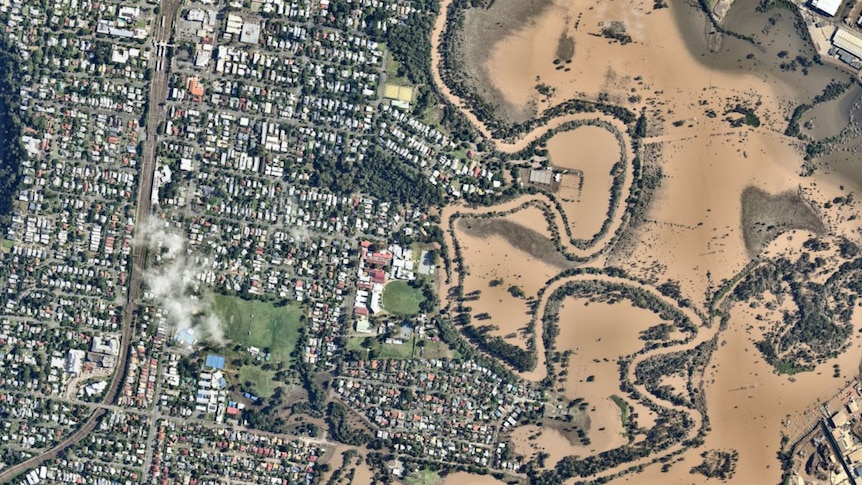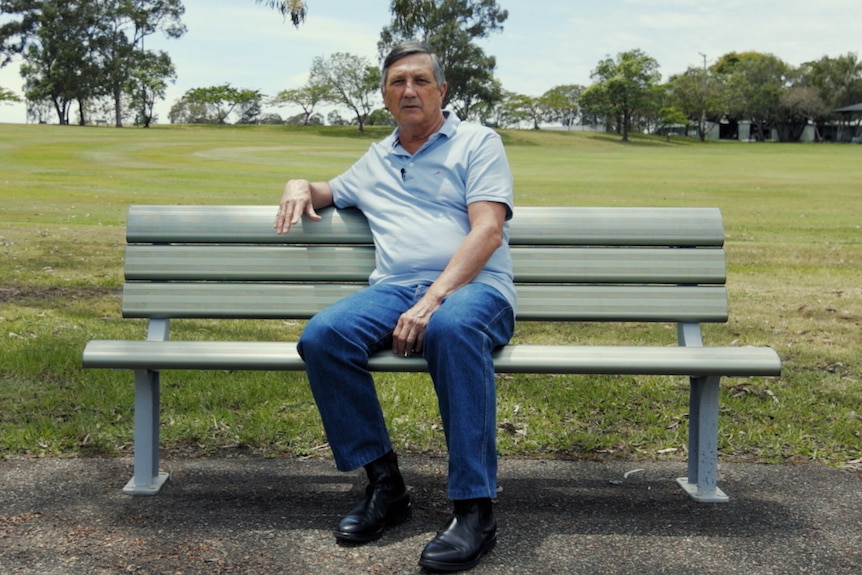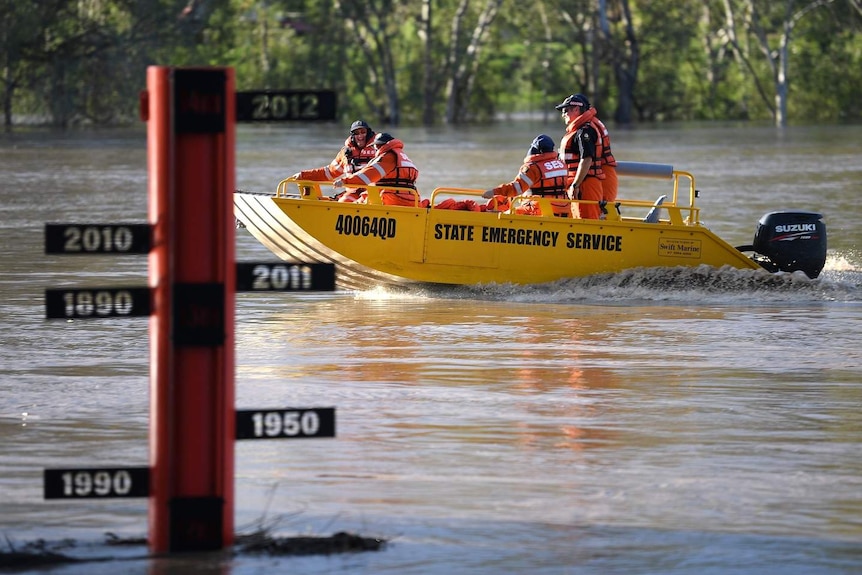By Emily Sakzewski

The former QFES commissioner says the disaster management system is under pressure
Public infrastructure damage in south-east Queensland has cost $492 million since the 1970s
A Climate Council report released today has examined the financial, social and economic costs of climate change-driven weather events.
It found Queensland has lost a total of about $30 billion from extreme weather disasters since 1970 — about three times that of Victoria.
The economic cost to Queensland from the floods in February and March alone was $7.7 billion, with an estimated $5.56 billion in insured losses across south-east Queensland and coastal NSW.
Brisbane suffered about $1.38 billion in insured losses from this year's floods, more than any other local government area in Australia.
It comes in the wake of the CSIRO and Bureau of Meteorology's biennial State of the Climate report, which found changes to weather and climate extremes are happening at an increased pace across the country.
And more extreme weather is likely to come this summer.
The BOM's official summer outlook suggests eastern Australia will see above-average rainfall with more flooding expected.
Professor Lesley Hughes, a co-author of the report and a professor of biology at Macquarie University, said with the amount of rain falling in some areas, there's not enough time between disasters for communities to recover.
"We've got a situation where the catchments in many parts of eastern Australia are already saturated, so they they can't really absorb more water."
Emergency services stretched to the limit
The emotional toll of seeing your home flood multiple times in one year is hard to fathom, but the people working to coordinate, sandbag, rescue and help clean up these disasters are also feeling the strain.
Former Queensland Fire and Emergency Services commissioner Lee Johnson said disaster-management and emergency service systems are under a great deal of pressure and "have been for some time".


Business bookings affected by unpredictability

How can we future-proof our cities?
Public infrastructure damage from weather disasters in south-east Queensland is estimated to have cost $492 million since the 1970s.
Dr Dorina Pojani, a senior lecturer in urban planning at the University of Queensland, said all land use, design, and transport decisions into the future should consider climate and weather events.
For example, approvals of developments on flood-prone land need to stop.
"At the same time, we don't want Brisbane to sprawl out further — as that would lead to more car driving," Dr Pojani said.
"The solution is to densify existing built-up areas which are protected from floods.
"Local residents will have to accept that the era of living in low-density housing is (or will soon be) over."
'The key to this whole situation'
The Climate Council's report states recent weather disasters have been "supercharged by climate change caused by the burning of fossil fuels".
Queensland produces the most coal of any state and more gas than every state except Western Australia.
In 2021–2022, the Queensland government provided $665 million in assistance to the fossil fuel industry, the bulk of which was spent on publicly owned coal mines, gas fields and fossil fuel power stations, according to the Australia Institute.
Earlier this year the Palaszczuk government announced it would increase the coal royalties rate, a decision that prompted an expensive advertising campaign from the Queensland Resources Council.

Brisbane has seen $1.38 billion in insured losses from flooding so far this year.(Supplied: Nearmap)
Queensland suffered more economic damage from extreme weather disasters than any other state or territory, and more extreme weather is on the way.
Key points:
Key points:
Disasters have cost Queensland about $30 billion since the 1970s
The former QFES commissioner says the disaster management system is under pressure
Public infrastructure damage in south-east Queensland has cost $492 million since the 1970s
A Climate Council report released today has examined the financial, social and economic costs of climate change-driven weather events.
It found Queensland has lost a total of about $30 billion from extreme weather disasters since 1970 — about three times that of Victoria.
The economic cost to Queensland from the floods in February and March alone was $7.7 billion, with an estimated $5.56 billion in insured losses across south-east Queensland and coastal NSW.
Brisbane suffered about $1.38 billion in insured losses from this year's floods, more than any other local government area in Australia.
It comes in the wake of the CSIRO and Bureau of Meteorology's biennial State of the Climate report, which found changes to weather and climate extremes are happening at an increased pace across the country.
And more extreme weather is likely to come this summer.
The BOM's official summer outlook suggests eastern Australia will see above-average rainfall with more flooding expected.
Professor Lesley Hughes, a co-author of the report and a professor of biology at Macquarie University, said with the amount of rain falling in some areas, there's not enough time between disasters for communities to recover.
"We've got a situation where the catchments in many parts of eastern Australia are already saturated, so they they can't really absorb more water."
Emergency services stretched to the limit
The emotional toll of seeing your home flood multiple times in one year is hard to fathom, but the people working to coordinate, sandbag, rescue and help clean up these disasters are also feeling the strain.
Former Queensland Fire and Emergency Services commissioner Lee Johnson said disaster-management and emergency service systems are under a great deal of pressure and "have been for some time".
Former commissioner Lee Johnson said he began to notice an increase in natural disasters in 2006 after Tropical Cyclone Larry.
(Supplied: Climate Council)
Mr Johnson, who is also a member of Emergency Leaders for Climate Action — a coalition of former senior emergency service leaders — said of the 225,000-odd staff involved in emergency services in Queensland, about 200,000 were volunteers.
He said the constant need to respond to disasters has taken a great toll on volunteers across the board, from emergency services to the CWA and Red Cross.
"They live in communities. And they're impacted by what's happening in the disaster sense, just as much as anybody else."
Mr Johnson, who is also a member of Emergency Leaders for Climate Action — a coalition of former senior emergency service leaders — said of the 225,000-odd staff involved in emergency services in Queensland, about 200,000 were volunteers.
He said the constant need to respond to disasters has taken a great toll on volunteers across the board, from emergency services to the CWA and Red Cross.
"They live in communities. And they're impacted by what's happening in the disaster sense, just as much as anybody else."
Most of Queensland's emergency services are volunteers.
(AAP: Dan Peled)
Mr Johnson believes there's room to evolve coordination between governments to better respond to weather disasters.
"So traditionally, seasonally, the bushfire season starts early in Queensland, and then moves into southern Australia," he said.
"We're into floods and cyclones while southern Australia is burning and we're able to share resources both ways, and we've done that over many years.
"That's getting harder and harder, so some thought has to go into how can we cross-border support each other better? What mechanisms can be introduced that might make that easier?"
Mr Johnson believes there's room to evolve coordination between governments to better respond to weather disasters.
"So traditionally, seasonally, the bushfire season starts early in Queensland, and then moves into southern Australia," he said.
"We're into floods and cyclones while southern Australia is burning and we're able to share resources both ways, and we've done that over many years.
"That's getting harder and harder, so some thought has to go into how can we cross-border support each other better? What mechanisms can be introduced that might make that easier?"
Business bookings affected by unpredictability
Innes Larkin, co-owner of Mount Barney Lodge in South East Queensland.
(Supplied: Climate Council)
Innes Larkin, the co-owner of Mount Barney Lodge in south-east Queensland, said his business has been affected by the new unpredictability in the weather.
Mr Larkin said the change has had an affect on people booking in advance.
"We've gone from getting two to three months of pre-bookings where we know our clearer picture of what's coming ahead to two to three days."
Mr Larkin wants Australian leaders to "take climate action seriously" and "fully commit to net-zero".
"You can't pretend to have a net-zero pathway and be opening up new coal and gas fields, those two are mutually exclusive and incompatible."
Innes Larkin, the co-owner of Mount Barney Lodge in south-east Queensland, said his business has been affected by the new unpredictability in the weather.
Mr Larkin said the change has had an affect on people booking in advance.
"We've gone from getting two to three months of pre-bookings where we know our clearer picture of what's coming ahead to two to three days."
Mr Larkin wants Australian leaders to "take climate action seriously" and "fully commit to net-zero".
"You can't pretend to have a net-zero pathway and be opening up new coal and gas fields, those two are mutually exclusive and incompatible."
How can we future-proof our cities?
Public infrastructure damage from weather disasters in south-east Queensland is estimated to have cost $492 million since the 1970s.
Dr Dorina Pojani, a senior lecturer in urban planning at the University of Queensland, said all land use, design, and transport decisions into the future should consider climate and weather events.
For example, approvals of developments on flood-prone land need to stop.
"At the same time, we don't want Brisbane to sprawl out further — as that would lead to more car driving," Dr Pojani said.
"The solution is to densify existing built-up areas which are protected from floods.
"Local residents will have to accept that the era of living in low-density housing is (or will soon be) over."
'The key to this whole situation'
The Climate Council's report states recent weather disasters have been "supercharged by climate change caused by the burning of fossil fuels".
Queensland produces the most coal of any state and more gas than every state except Western Australia.
In 2021–2022, the Queensland government provided $665 million in assistance to the fossil fuel industry, the bulk of which was spent on publicly owned coal mines, gas fields and fossil fuel power stations, according to the Australia Institute.
Earlier this year the Palaszczuk government announced it would increase the coal royalties rate, a decision that prompted an expensive advertising campaign from the Queensland Resources Council.
Queensland Premier Annastacia Palaszczuk said she was was "angry" and "disappointed" at the Queensland Resources Council over its campaign.
(ABC News: Christopher Gillette)
Professor Hughes said governments "can't have it both ways".
"We've got communities absolutely suffering from the impacts of increasing climate-related disasters, and some of the largest companies in the world making extraordinary profits being propped up by the Australian taxpayer," she said.
Mr Johnson agreed.
"We really must reduce greenhouse gas emissions, which is the burning of coal, oil and gas as quickly as we possibly can," he said.
"That's the key to this whole situation."
Professor Hughes said governments "can't have it both ways".
"We've got communities absolutely suffering from the impacts of increasing climate-related disasters, and some of the largest companies in the world making extraordinary profits being propped up by the Australian taxpayer," she said.
Mr Johnson agreed.
"We really must reduce greenhouse gas emissions, which is the burning of coal, oil and gas as quickly as we possibly can," he said.
"That's the key to this whole situation."
No comments:
Post a Comment